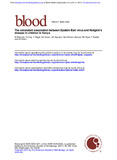| dc.contributor.author | Weinreb, M | |
| dc.contributor.author | Day, PJ | |
| dc.contributor.author | Niggli, F | |
| dc.contributor.author | Green, EK | |
| dc.contributor.author | Nyong'o, AO | |
| dc.contributor.author | Othieno-Abinya, NA | |
| dc.contributor.author | Riyat, MS | |
| dc.contributor.author | Raafat, F | |
| dc.contributor.author | Mann, JR | |
| dc.date.accessioned | 2013-06-11T13:16:46Z | |
| dc.date.available | 2013-06-11T13:16:46Z | |
| dc.date.issued | 1996-05 | |
| dc.identifier.citation | Blood. 1996 May 1;87(9):3828-36 | en |
| dc.identifier.uri | http://hinari-gw.who.int/whalecomwww.ncbi.nlm.nih.gov/whalecom0/pubmed/8611709 | |
| dc.identifier.uri | http://erepository.uonbi.ac.ke:8080/xmlui/handle/123456789/31659 | |
| dc.description.abstract | Recent studies have suggested that Epstein-Barr virus (EBV) may play a role in the etiology of Hodgkin's disease (HD). In a previous study, we used a latent membrane protein 1 (LMP1)-specific antibodies to examine archival material from 74 British children with HD and found 50% of cases to be positive. It is known that there are geographic and ethnic variations in the incidence of HD. We have investigated LMP1 status in formalin-fixed, paraffin wax-embedded lymph nodes with HD involvement from 53 children and 48 adults from Kenya using immunohistochemical staining. We also developed sensitive and specific in vitro gene amplification protocols for examining the EBV strain type in such material using several combinations of primers derived from the EBNA 2 and EBNA 3 coding regions. LMP1 positivity was present in 100% of the pediatric cases (two lymphocyte-predominant, 25 nodular sclerosis, 16 mixed cellularity, 5 lymphocyte depletion, and 5 unclassified) and in 66% of the adult cases (two of three lymphocyte-predominant, 26 of 39 nodular, sclerosis, two of two mixed cellularity, and two of four lymphocyte depletion). Tests to type the EBV strain were undertaken in 25 EBV-positive pediatric cases. A combination of type-specific polymerase chain reactions for EBNA 2 and EBNA 3C genes indicated that seven patients had type 1, eight had type 2, and 10 had dual infections with both types. Five cases with dual infections were further investigated using a sensitive in situ hybridization for the EBV-encoded, small nuclear nonpolyadenylated RNAs (EBERs). EBER transcripts were detected in Reed-Sternberg and Hodgkin cells and in occasional infiltrating lymphocytes. These observations indicate that in Kenya EBV is consistently associated with pediatric cases of HD, and that biopsies from a number of such cases appear to carry both type 1 and type 2 viral sequences. | en |
| dc.language.iso | en | en |
| dc.publisher | University of Nairobi | en |
| dc.title | The consistent association between Epstein-Barr virus and Hodgkin's disease in children in Kenya. | en |
| dc.type | Article | en |
| local.publisher | School of medicine,University of Nairobi | en |
| local.publisher | Department of Oncology, Children's Hospital, Birmingham, UK. | en |


